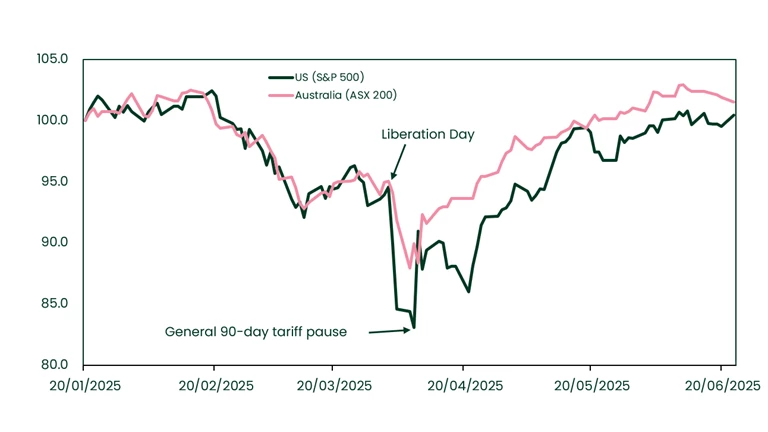June 2025
Investment market volatility
Following strong gains in 2024, global equity markets have experienced a high level of volatility during 2025 so far. Key drivers of the volatility have been large changes in US tariffs on imported goods, US Congress considering large tax cuts through the One Big Beautiful Bill and the conflict between Israel and Iran.
Equity market performance since Trump inauguration on 20 January

Source: LSEG (Equity indices have been indexed to 100 as at 20 January)
US tariffs
One of the most impactful events in 2025 was the announcement of ‘reciprocal’ tariffs on 2 April (‘Liberation Day’) by US President Donald Trump. While increased tariffs were flagged prior to the US election, the speed, magnitude and chaotic nature of the tariff policy unsettled investors. This resulted in sharp falls in equity markets following the Liberation Day announcement (see chart). For example, the US S&P 500 index fell by more than 10% over the two days following the announcement.
A moderation in the average US tariff rate soon after the Liberation Day announcement has helped underpin strong gains in equity markets, with some markets around their highs for the year. The US S&P 500 has nearly recovered its losses from its all-time high in February. Following sharp falls in March and the early part of April, the Australian equity market (ASX 200) has recovered and is now close to its high for the year.
While there has been a progressive moderation in US tariffs, the current level translates into a large increase in the effective tariff rate. An important recent change has been the material moderation in the US/China tariffs.
In coming weeks, the US is expected to reveal the tariff rate for countries that have not been able to negotiate a ‘trade deal’ (i.e. most countries). This could be a source of increased market volatility, particularly if the rates are higher than expected. It appears that investors are not expecting particularly onerous levels to be announced versus the current levels.
US fiscal policy
On 16 May, Moody’s downgraded the US credit rating. Instead of looking to improve the fiscal outlook, the US Congress is currently considering passing the One Big Beautiful Bill, which is expected to increase US budget deficits by around USD 3 trillion over the next 10 years. While the Bill is likely to boost growth over the near term, some investors are now more concerned about the sustainability of the US debt outlook. This has recently put some upward pressure on US long-term interest rates.
Israel/Iran conflict
On 13 June, Israel launched a surprise attack on key Iranian nuclear and military facilities, with the aim of eradicating Iran’s capacity to produce nuclear weapons. The US joined Israel in the conflict on 22 June through selective bombing of key Iranian targets. At the time of writing, a ceasefire is in place. During the period since 13 June, global equity markets have been relatively resilient, with only modest falls when the conflict commenced. The recent ceasefire announcement has underpinned positive sentiment, with equity markets moving higher and oil prices falling.
Conclusion
The year 2025 has been characterised by substantial market volatility, influenced by a range of global events. While global equity markets have experienced sharp falls for some of this period, they have generally rebounded strongly despite considerable uncertainty about the outlook from a macroeconomic and geopolitical perspective. The experience over 2025 so far is a reminder that equity markets can be very volatile and that a long-term perspective is important during turbulent times.
Investment returns are not guaranteed. Past performance is not a reliable indicator of future returns.

